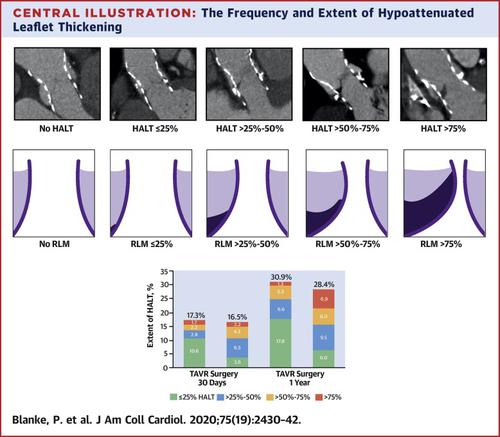当前位置:
X-MOL 学术
›
J. Am. Coll. Cardiol.
›
论文详情
Our official English website, www.x-mol.net, welcomes your
feedback! (Note: you will need to create a separate account there.)
Leaflet Thickening or Immobility Following Aortic Valve Replacement: Results from the Evolut Low Risk Sub-study
Journal of the American College of Cardiology ( IF 21.7 ) Pub Date : 2020-05-01 , DOI: 10.1016/j.jacc.2020.03.022 Philipp Blanke 1 , Jonathon A Leipsic 1 , Jeffrey J Popma 2 , Steven J Yakubov 3 , G Michael Deeb 4 , Hemal Gada 5 , Mubashir Mumtaz 5 , Basel Ramlawi 6 , Neal S Kleiman 7 , Paul Sorajja 8 , Judah Askew 8 , Christopher U Meduri 9 , James Kauten 9 , Serguei Melnitchouk 10 , Ignacio Inglessis 10 , Jian Huang 11 , Michael Boulware 11 , Michael J Reardon 12 ,
Journal of the American College of Cardiology ( IF 21.7 ) Pub Date : 2020-05-01 , DOI: 10.1016/j.jacc.2020.03.022 Philipp Blanke 1 , Jonathon A Leipsic 1 , Jeffrey J Popma 2 , Steven J Yakubov 3 , G Michael Deeb 4 , Hemal Gada 5 , Mubashir Mumtaz 5 , Basel Ramlawi 6 , Neal S Kleiman 7 , Paul Sorajja 8 , Judah Askew 8 , Christopher U Meduri 9 , James Kauten 9 , Serguei Melnitchouk 10 , Ignacio Inglessis 10 , Jian Huang 11 , Michael Boulware 11 , Michael J Reardon 12 ,
Affiliation

|
BACKGROUND
Subclinical leaflet thrombosis has been reported after bioprosthetic aortic valve replacement, characterized using 4-dimensional computed tomographic (CT) imaging by hypoattenuated leaflet thickening (HALT) and reduced leaflet motion (RLM). The incidence and clinical implications of these findings remain unclear. OBJECTIVE
This study sought to determine the frequency, predictors and hemodynamic and clinical correlates of HALT and RLM after aortic bioprosthetic replacement. METHODS
A prospective subset of patients not on oral anticoagulation enrolled in the Evolut Low Risk randomized trial underwent CT imaging 30 days and 1 year after TAVR or surgery. The primary endpoint was the frequency of HALT at 30 days and 1 year, analyzed by an independent core laboratory using standardized definitions. Secondary endpoints included RLM, mean aortic gradient, and clinical events at 30 days and 1 year. RESULTS
At 30 days, the frequency of HALT was 31/179 (17.3%) for TAVR and 23/139 (16.5%) for surgery; the frequency of RLM was 23/157 (14.6%) for TAVR and 19/133 (14.3%) for surgery. At 1 year, the frequency of HALT was 47/152 (30.9%) for TAVR and 33/116 (28.4%) for surgery; the frequency of RLM was 45/145 (31.0%) in TAVR and 30/111 (27.0%) for surgery. Aortic valve hemodynamics were not influenced by the presence or severity of HALT or RLM at either time point. The rates of HALT and RLM were similar after implantation of supraannular, self-expanding transcatheter or surgical bioprostheses. CONCLUSIONS
We found that the presence of CT imaging abnormalities of aortic bioprostheses were frequent but dynamic in the first year after self-expanding transcatheter and surgical aortic valve replacement, but that these findings did not correlated with aortic valve hemodynamics after aortic valve replacement in patients at low risk for surgery.
中文翻译:

主动脉瓣置换术后瓣叶增厚或不动:来自 Evolut 低风险子研究的结果
背景 已经报道了生物人工主动脉瓣置换术后亚临床小叶血栓形成,其特征是使用 4 维计算机断层扫描 (CT) 成像通过低衰减小叶增厚 (HALT) 和减少小叶运动 (RLM)。这些发现的发生率和临床意义仍不清楚。目的 本研究旨在确定主动脉生物假体置换后 HALT 和 RLM 的频率、预测因素以及血流动力学和临床相关性。方法 纳入 Evolut 低风险随机试验的一组未接受口服抗凝治疗的前瞻性患者在 TAVR 或手术后 30 天和 1 年接受了 CT 成像。主要终点是 30 天和 1 年的 HALT 频率,由独立核心实验室使用标准化定义进行分析。次要终点包括 RLM、平均主动脉梯度和 30 天和 1 年的临床事件。结果 30 天时,TAVR 的 HALT 频率为 31/179(17.3%),手术为 23/139(16.5%);TAVR 的 RLM 频率为 23/157(14.6%),手术为 19/133(14.3%)。1 年时,TAVR 的 HALT 频率为 47/152(30.9%),手术为 33/116(28.4%);TAVR 的 RLM 频率为 45/145(31.0%),手术为 30/111(27.0%)。在任一时间点,主动脉瓣血流动力学不受 HALT 或 RLM 的存在或严重程度的影响。植入环上自膨式经导管或手术生物假体后,HALT 和 RLM 的发生率相似。
更新日期:2020-05-01
中文翻译:

主动脉瓣置换术后瓣叶增厚或不动:来自 Evolut 低风险子研究的结果
背景 已经报道了生物人工主动脉瓣置换术后亚临床小叶血栓形成,其特征是使用 4 维计算机断层扫描 (CT) 成像通过低衰减小叶增厚 (HALT) 和减少小叶运动 (RLM)。这些发现的发生率和临床意义仍不清楚。目的 本研究旨在确定主动脉生物假体置换后 HALT 和 RLM 的频率、预测因素以及血流动力学和临床相关性。方法 纳入 Evolut 低风险随机试验的一组未接受口服抗凝治疗的前瞻性患者在 TAVR 或手术后 30 天和 1 年接受了 CT 成像。主要终点是 30 天和 1 年的 HALT 频率,由独立核心实验室使用标准化定义进行分析。次要终点包括 RLM、平均主动脉梯度和 30 天和 1 年的临床事件。结果 30 天时,TAVR 的 HALT 频率为 31/179(17.3%),手术为 23/139(16.5%);TAVR 的 RLM 频率为 23/157(14.6%),手术为 19/133(14.3%)。1 年时,TAVR 的 HALT 频率为 47/152(30.9%),手术为 33/116(28.4%);TAVR 的 RLM 频率为 45/145(31.0%),手术为 30/111(27.0%)。在任一时间点,主动脉瓣血流动力学不受 HALT 或 RLM 的存在或严重程度的影响。植入环上自膨式经导管或手术生物假体后,HALT 和 RLM 的发生率相似。











































 京公网安备 11010802027423号
京公网安备 11010802027423号